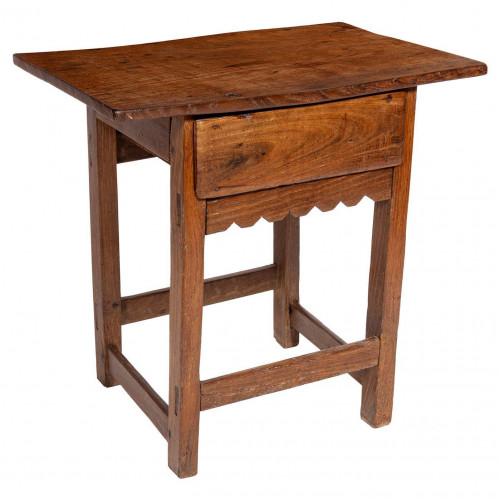Half-clothed woman seated on floor, 1917
10931
HORACE BRODSKY (1885-1969) :
Half-clothed woman seated on floor
Signed in black ink lower right., 'H. Brodzky '17'
Pen in ink on watermarked paper
Inscribed verso in pencil with dealer's markings; top edge, '1542', '56' (crossed out), '8a'; lower edge, '3304'
Condition: small tear u.l. (detached from corner); three small pin holes, losses to edges of sheet.
Sheet size 28.0 cm (11 in) x 21.7 cm (8 ½ in)
In a gilded frame
Framed height 41 cm (16 ¼ in) x width 36 cm (14 ¼ in)
RELATED TO:
Horace Brodzky Seated Nude 1917, Etching. British Museum Collection of Drawings and Prints. 1967 reprint made by London Graphic Arts in an edition of 30. Listed as Cat.no. 134 in "Horace Brodzky 1885-1969" a retrospective exhibition catalogue by Frances Spalding, London, Boundary Gallery, 10 October - 15 November 1989
EXHIBITION HISTORY : Horace Brodzky 1885-1969, Michael Parkin Fine Art Ltd, 11 Motcomb Street, London, SW1 X8LB, 26 June - 20 July 1974, Cat. No. 58 of 95 works
Because of the date on the drawing it was possibly exhibited in Horace Brodzky. Exhibition of paintings, drawings, etchings, etc, The Penguin, 8 East 15th Street, New York, 18 April - ? 1918, perhaps Cat. No 60-64, each titled Pen Drawing No 1 -5. The exhibition was reviewed in Sun, 12 August 1918 and New York Times, 14 April 1918.
This work is probably related to 31, Nude, ink, 1917 that is listed in the Exhibition leaflet of the exhibition Horace Brodzky organised in February of 1966 by the Mercury Gallery, celebrating Brodzky's 81st birthday.
Half-clothed woman seated on floor
A unique drawing, this work is typical of Brodzky's early nudes with its economy in the use of the line and the seemingly relaxed, informal pose of the model. The spontaneous feel of many of Brodzky's drawings does in now way indicate that works such as the present drawing are purely sketches or studies. In fact Brodzky was known to make perhaps twenty or thirty drawings at a sitting and of those he preserved perhaps only a handful, only those who 'pass his rigorous censorship [… those that] sum up qualities resulting from the perfect collaboration of hand and eye and sensibility' (p. 15, Forty Drawings by Horace Brodsky 1935 by James Laver, Keeper of the Department of Engraving, Illustration and Design, V&A Museum).
Laver also wrote that 'Brodkzy preferred a pose that showed the body from an unexpected angle, daringly foreshortened or with the weight of the various parts freed from the monotony of the standing pose. He liked to see his models from above, the limbs relaxed, and […] he made many of this drawings from a step-ladder drawn up close to the platform on which the model is lying'. This preference is well illustrated here where the model is sitting a fairly relaxed, if posed, position with her legs crossed in a slight contraposto.
HORACE BRODZKY (1885-1969)
Horace Brodzky was born in Melbourne, Australia, in 1885 but he spent most of his active life in London where he lived from 1923 until his death in 1969. He was the only son of a journalist on the Melbourne Herald who also taught Hebrew. Brodzky studied briefly at the art class of the Melbourne National Gallery (1904-05), emigrated to San Francisco in 1905, moved to New York in 1906 and on to London in 1908 where he attended the City and Guild Art School in Kennington in 1911. Brodzky returned to New York and supported himself between 1915 and 1923 as a waiter, a model and an editor of various periodicals and magazines while painting. He described himself as an 'affectionate Boswell' on publishing Henri Gaudier-Brzeska a memoir in 1933. (p. 287, Lisa Tickner Modern Life and Modern Subjects. British Art in the Early 20th Century). In 1967, two years before Brodzky died, Macey's department store in New York put on an exhibition of his oils, drawings and graphics.
As an artist, Brodzky was a pioneer with the London Group and he worked closely with the Vorticists in the early 20th century, collaborating with Wyndham Lewis, Lucian Pissarro, Mark Gertler, David Bomberg and Jacob Epstein . His work was used also to illustrate publications by Ezra Pound, Eugene O'Neill, Upton Sinclair and Theodore Dreisler. In 1912 when Brodzky became the first Australian artist to exhibit at the Venice Biennale, he also met Henri Gaudier-Brzeska, who would become a personal friend and with whom he worked very closely until Gaudier-Brzeska's untimely death in 1915. In 1933, Brodzky, who had also expanded his activities to include art critic and journalist, wrote and published a biography of Gaudier-Brzeska.
Although Brodzky was also a painter in oils and watercolours, he is particularly well known as a draughtsman and a highly original printmaker. His many woodcuts and lino-cuts have been favourably compared with the prints produced by the German Expressionists and were distinctly avant-garde.
According to Paul Grinke (Horace Brodzky, 1966), in Brodzky's practice painting and drawing 'are almost two entirely unrelated fields of activity, while his paintings are mainly genre subjects, often infused with a powerful Jewish feeling, drawings are very different in feeling and technique, particularly with Brodzky's use of foreshortening. Comparisons have often been made with Gaudier-Brzeska, who in addition to being an exceptional sculptor, was also a very accomplished and prolific draughtsman. There are indeed parallels in the general treatment of the human figure although Brodzky's works retain an essential personal flavour. His drawings show an incredible economy of means, often using favouring the austerity of the single line but he is able nevertheless able to reach a great deal of expression.
20th Century
1917
British
Commemorative










